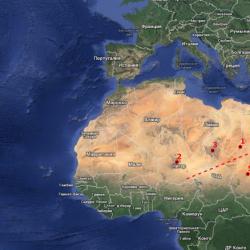When people die out. Five reasons for the possible extinction of humanity. Late Devonian mass extinction
While ordinary people are trying to guess what could cause the entire human race to become extinct, scientists have long been thinking about the question of saving humanity. The death of humanity is inevitable, because ten phenomena are already known that will erase the human presence on Earth. It is possible that humanity will be able to cope with one disaster, but after a while a second one will come. Both the Earth itself and space become sources of potential threats. But, most likely, humanity will kill itself, can this be avoided? Let's think about it.
The disappearance of resources is the result of overpopulation.
In the last 10-13 years, the population on the planet has grown by 1 billion people; the UN predicts that in a hundred years the number of inhabitants of planet Earth will reach 9-12 billion. Already by 2025, 2 billion people, which is a third of the world's population at the moment, will constantly need fresh water.
Cities will constantly grow, and the area of land for agriculture will decrease. The problem of food supply will remain the same, and famine is expected. But humanity will not escape with hunger and thirst alone; many minerals that are necessary to maintain the benefits of life will be exhausted. When there is a shortage of resources, then war begins. Some forecasts say that the disappearance of irreplaceable natural resources will lead to depopulation. About half a million or a million people will remain on Earth. Civilization will be an agrarian-hunting phase from which it will not emerge because there will be no more minerals.
How to prevent this?
To begin with, it is worth limiting the constant growth of the population, then using technologies that will allow mining minerals on asteroids, as well as using sea water. Build farms vertically and in cities, constantly recycle waste, use more highly productive agricultural products, and also reduce the cost of producing artificial meat as much as possible.
Pollinator extinction

It is not even necessary for the population to grow in numbers for food to become insufficient. It will be enough that the bees disappear. One third of all agricultural production depends solely on pollinators. No bees - no soybeans, sunflowers, buckwheat, cabbage, onions, tomatoes, zucchini, cucumbers, lemons, nuts, coffee and several dozen other cultivated plants.
The number of bees is declining every year, for example, in America about 30% of bee families die out every year, and in Europe - 20%. Of course, new bees appear, but the extinction process is faster than the recovery process. For the first time, news of the mass extinction of bees appeared in the 90s, and in 2006, colony collapse syndrome was described in the United States. The bees left the hive, leaving the queen behind.
Humanity has not yet lost all pollinators, but over the past 50 years, the production of bee colonies has decreased by 2 times. If the trend continues, humanity may be left without beneficial insects and lose a huge share of crops. With such a prospect, it won’t take long for it to become extinct.
How to save bees?
First you need to find the reason why the named syndrome occurs. Possible sources of the problem may include: pesticides, Varroa mites, new unexplored diseases, or a combination of these and other factors.
Scientists at Harvard University suggest that neonicotinoids may be the cause of family destruction. These are drugs designed to kill insect pests. Scientists conducted an experiment; in winter, the syndrome began to appear in the experimental family of bees, and in the control group, all the hives were intact.
Of course, you can find a replacement for the honey bee, such as using wasps or solitary bees. In the United States, they are already breeding a solitary garden bee, which can be used as a “backup” pollinator. The new species of bee will not suffer from the syndrome because it does not create colonies; one such bee can pollinate 50 times more plants than a regular honey bee. Scientists presented the results of calculations, in which it was written that a female solitary garden bee lands on flowers about 6,000 times in one season. Today, farmed orchard bees pollinate about a hundred hectares of almonds in California.
Chinese gardeners have found a radical solution; in years when many bee colonies die out, the Chinese engage in manual pollination of plants using special brushes. For China, this solution is acceptable, but for countries with few human resources, it is not.

Medicine has done its job - natural selection has practically no effect on humans. Just a couple of centuries ago, epidemics wiped out the unadapted population. Now humanity has antibiotics and advanced diagnostics along with surgery. Poor health is no longer an obstacle to reproduction.
Now there is an accumulation of genetic defects; people with a large number of mutations usually have weak immunity and low life expectancy. Genetic defects appear in every new generation; without natural selection, a person may find himself on the verge of genetic degeneration and extinction.
How to deal with this?
The news is far from good, and it is very difficult to accurately determine the scale of this problem. To create an action plan, you need data, but you don’t have it. Although there is still good news, Alexander Markov, a biologist, says that selection has not stopped, it has simply become less noticeable. In a large human population, a weak negative mutation will be rejected, it will not be able to achieve one hundred percent purity. The sheer size of the population on Earth protects humans from mildly harmful mutations and their spread.

Global warming is very scary; the melting of glaciers will lead to sea levels rising by 65 meters. People will have to forget about London, the Atlantic coast of the USA, Venice, Holland and Denmark, Astrakhan, St. Petersburg and many other cities.
According to the interactive map NationalGeographic, which was developed on the basis of a model presented by the US National Center for Environmental Information, as well as the General Directorate for Climate Change in the European Union, then we expect fires and the spread of tropical diseases. It turns out that the unflooded part of humanity will die from disease and hunger. While all this does not sound very plausible, there is reason to think deeply. The European Space Agency presented a report that stated that the ice of Antarctica is melting 15% faster than expected.
How to prevent global warming?
Reports from a monitoring station located in Mauna Loa, Hawaii, show that the concentration of CO 2 in the atmosphere is constantly increasing. 400 ml per 1 cubic meter. air – this figure is determined in 2015. Reports are also coming from the US National Oceanic and Atmospheric Administration that there are now 120 ppm more greenhouse gases than in pre-industrial times. It is important that their number almost doubled after the 80s.
Two degrees for the average temperature of the Earth is a disaster. This does not mean that our planet will become any warmer. One continent will suffer from frosts, the other from abnormal heat. Scientists believe that a catastrophe can be avoided; for this it is necessary, starting this year, to emit no more than 1200 billion tons of CO 2 into the atmosphere. While that figure is difficult to achieve, it's worth keeping in mind methane, a byproduct of animal agriculture. Dr. Kirk Smith, a professor of global environmental health at the University of California, Berkeley, says that 1 ton of methane currently being released into the atmosphere contributes more to warming than 1 ton of CO2. 2.
There are 2 options for salvation: the first is to reduce methane and CO 2 emissions, the second is to abandon industrial livestock farming. To stop warming from continuing, we need to start now, because emissions will only increase until 2025. Reducing emissions means giving up economic growth; this, of course, is not very realistic. It’s probably worth moving away from the seas and growing drought-resistant crops.
Self-destruction with nuclear weapons

The outbreak of a nuclear war is most likely the most realistic option for the end of the world. Nine states now have nuclear weapons; the risk has doubled since the Cold War. Preliminary calculations show that a child born now has a 10% chance of dying from a nuclear weapon.
What should we do?
When struck by a nuclear bomb, not the entire population dies; for example, the Japanese Tsutomu Yamaguchi was able to live to be 90 years old, and he was in both Hiroshima and Nagasaki. A person can save himself, the main thing is to hide in time.
The explosion is not as terrible as its consequences: the effects of radiation and the onset of nuclear winter. Alan Robock, Richard Turco, and Owen B. Toon produced calculations that showed that if the United States attacked China and Russia, 2,200 atomic bombs would be used. The total explosion will release 86 million tons of soot into the atmosphere, enough to trigger the onset of the Ice Age.
Is a person able to survive in such conditions? Unknown. Humanity should strive for complete disarmament; nuclear states have been working on this for many years, but so far without success. So it's better to know where the nearest shelter is.
Perhaps many have ever wondered how long it will exist on Earth and whether humanity is in danger of complete extinction. But there are many pseudo-scientific theories about this, but in fact there are at least 15 reasons why people may disappear from the face of the planet within the next few hundred years.
1. Overpopulation

This has already been discussed more than once. Before the Industrial Revolution, the question of how to support so many people was not as pressing as it is today. Of course, railroads, steam engines and massive farms “came to the rescue” at that time, but what will happen next is anyone’s guess.
2. Nuclear Armageddon

Naturally, this is only a hypothetical problem... at least until someone presses the red button. How long will humanity be able to control its impulses is a big question that is becoming increasingly relevant as more and more countries acquire nuclear warheads at their disposal.
3. Antibiotic resistance

Although scientists in the United States have recently succeeded in developing so-called superbiotics, people are rapidly approaching a time when all modern antibiotics will be useless against evolving microbes. This could potentially take humanity back to a time when even a paper cut could kill a person.
4. Gamma-ray bursts

It may be unlikely, but it is possible that a high-energy explosion in a distant galaxy (a supernova explosion) could have long-term consequences for our planet. This can happen at any moment, so a period of a thousand years is not that long.
5. Cyberwars

This is directly related to terrorism and the increase in the number of “radical groups” on the world stage. Where historically rogue groups and protesters had to rely on essentially guerrilla tactics, today they can wreak havoc anywhere in the world with the click of a button. It might not wipe out humanity, but it could certainly cause enough chaos for "everything to go downhill."
6. Resource depletion

While this may not directly lead to the end of humanity, such a situation could very well lead to the end of civilization. Is it worth mentioning what this entails?
7. Super collider

Ever since the Large Hadron Collider was built, there has been a lot of controversy surrounding it. While it certainly helps scientists understand the world, there is a small chance that humans could accidentally create a miniature black hole.
8. Drought

Although more than 70 percent of the planet is covered in water, only 3 percent of it is drinkable. With the world's freshwater supplies steadily declining, this could lead to both freshwater wars and extinction. It is also worth considering global warming, which is getting worse every year.
9. Fasting

Most people who read this have no idea what hunger is. But at the moment, about 800 million people on the planet are starving. At the same time, the world's population is constantly growing.
10. Superhumans

Given genetic advances and “baby programming,” the possibility already exists that governments will begin to program their citizens to be completely loyal in advance. It remains to be seen at what point such people will actually cease to be human.
11. Biological warfare

As genetic engineering becomes more and more advanced, very unpleasant things will become possible pretty soon. This is almost the same thing as antibiotic resistance, except that the process will be intentional.
12. Extinction

Overpopulation has already been mentioned above, but the opposite option is also quite possible. There is evidence that as countries become more developed, people are choosing not to have children. For example, in Japan the government has long been trying to take at least some measures to “force” young people to procreate. Japan is not alone in its demographic crisis; the same thing is happening in Europe.
13. Aliens

Now many may advise “adjusting your tin foil hat.” But most scientists agree that the likelihood of extraterrestrial life is quite high. In addition, it will most likely be more advanced than humanity. It is for this reason that many people, such as Stephen Hawking and Elon Musk, are against sending messages into space through the SETI (Search for Extraterrestrial Intelligence) program.
14. Solar storms

While most solar storms are relatively harmless, what is known is that they can fry transformers and negatively impact the power grid. And if a really big solar storm happens, it's anyone's guess how much damage it will cause.
15. Mercury

Scientists noted that there is a one percent chance that the orbit of this planet may be unstable due to the gravitational pull of Jupiter. Computer simulations showed four possible outcomes: the planet being ejected from the solar system, colliding with the Sun, colliding with Venus, or colliding with Earth.
However, actions can also lead to the apocalypse. However, we hope that this will not happen.
One day there will come a time when people will no longer walk on this planet. This thought is unpleasant, but realistic. Every day of our lives is just a race towards the inevitable end. Scientists have suggested how this will happen and when. Here are the most likely theories.
1) Artificial intelligence - 20 years
People are creating faster and more powerful computers every day. But when will he become too powerful? Some scientists say that at some point the robot may see humans as imperfect beings and try to eradicate us. We can't be strong enough to stop them.
2) Nuclear war - 10-50 years

Every day there is a threat of nuclear war from some country, which makes this extinction theory incredibly plausible and the most likely. Unfortunately, we have no idea when this will happen. Everything depends on one click of a button.
3) Animal extinction - 100 years

Recently, many leading scientists have been putting forward the theory that we are now on the verge of the 6th mass extinction in history. We are not talking about people, as long as we are talking only about large animals. Without large predators roaming the earth, the number of rodents that carry terrible diseases will increase exponentially. In addition, without large animals there will be less food for people, and no food means no people.
4) Black holes - Any Day

The probability of our planet falling into an external black hole is not very high. But scientists are playing with the Large Hadron Collider, which could theoretically not only recreate some of the events that caused the big bang, but also potentially create a black hole that would suck in the entire planet.
5) Global warming - 100 years

This has been the most discussed topic in the last few years. There are many skeptics, but scientists insist that the effects of global warming are real and backed by evidence. The ice caps are melting and could wipe out much Arctic wildlife and raise sea levels, making not only some cities but entire continental masses uninhabitable.
6) Alien Invasion - Any Day

There is probably intelligent life somewhere in our infinite universe. If alien life exists and is advanced enough to come to our planet, imagine what kind of military technology aliens might have. Some scientists are starting to hope that we are truly alone in the universe, because if we are not, it could mean the end of humanity as we know it.
7) Pandemics - Any Day

Viruses constantly mutate and adapt. Scientists experiment with creating and destroying new diseases every day. If we had to run to the laboratory, who knows if we could survive it. Diseases always pop up out of nowhere and no one can say what will appear tomorrow.
8) DNA failure - 6000 years

DNA is the basis for all human life. What happens when this foundation begins to fail? We will be destroyed. Unfortunately, this is currently happening. Our bodies are much weaker and more prone to disease than they were previously. Our dependence on medical technology has made our bodies soft and vulnerable and there is nothing we can do about it. We now have thousands of genetic mutations in our DNA and each new generation creates even more. These mutations won't make you look like Wolverine or Spider-Man, but quite the opposite. Our bodies become more prone to contracting cancer and other deadly diseases.
9) Nanotechnology - 10-500 years

Nanotechnology may be hailed as the savior of modern medicine, but it could also lead to the demise of us all. Just like artificial intelligence, these robots can see humans as innately flawed, destroying us from the inside.
10) Overpopulation - 100 years

Many scientists believe that our biggest problem is overpopulation. Some suggest that humanity could disappear within 100 years due to this problem. Overpopulation can be seen as a catalyst for many of the above potential theories of human extinction. Our population has doubled in the last 35 years and we continue to grow, which could lead to resource and food shortages and lead to war.
Author of Green Hell: How Environmentalists Plan to Control Your Life and What You Can Do to Stop Them. No, it’s not intended to be a parody. For Earth Day 2009, Laura Ingraham invited Les to her radio program early
On July 3, 2008 in a half-hour radio broadcast, Stephanie Potter interviewed Les about VHEMT. Archived at: The Recovery Zone.
In Time magazine’s number one non-fiction book of 2007, The World Without Us, Alan Weisman generously presents.
A major goal of our website is to advance the population-awareness movement, which seems to have become stalled, and may have slipped back to where it was more than 35 years ago. Progressive population awareness groups advocate a one-child average and two maximum, but few, if any, dare to advocate zero procreation. Environmental groups avoid the controversial topic, preferring to work on the consequences of our excessive breeding. Scientists acknowledge the population’s effects, but also decline to include it in their suggested solutions.
Several online forums for sharing and discussing ideas related to voluntary human extinction are available. One for VHEMT Volunteers and Supporters includes over 1,400 subscribers and another includes more than 4,000.
On April 8, 2010, French TV, Global Arte, broadcast a 2:16 minute anti-natalist, pro-planet video which included VHEMT. (in French)






